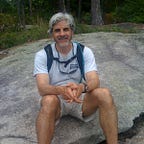Growing Around
The shape of a tree tells its developmental story. Trees grow around objects blocking their “lightward” trajectory. In some cases, these objects are permanent, making the tree’s story easily discernible. Yet in others, the original obstacle (e.g., another tree) may have been displaced or rotted away leaving only mystery and speculation.
Our personal developmental story reveals itself, not only in our physical presentation, but through our thoughts, feelings and behavior. Like trees, we too “grow around” the circumstances and people we encounter in our “lifeward” trajectory. We may remember some of the stories and circumstances behind these shaping experiences, but more likely they were never explicitly recorded. Regardless, these experiences have directed our growth. Conditioning and emotional learning write much of our implicit guidebook, which is revealed in our immediate experience and subjectively felt as we encounter life.
Conditioning refers to types of paired learning experiences, which are often involuntary. Classical conditioning, which we associate with “Pavlov’s dog,” refers to experiences that are paired together to the point where the paired stimulus reflexively induces the response normally associated with the other stimulus. Operant conditioning, which we associate with B. F. Skinner’s pigeons, is a form of instrumental learning that is based on whether behavior is reinforced or punished. Another significant way we are shaped is through social learning, which is based on direct instruction, modeling or observing the consequences of other people’s behavior. Social learning can be convoluted due to the subjective nature of our perception. Our interpretations are personal and do not always reflect what the “teacher” intended. Much of our learning is both implicit and emotional, bypassing our conscious awareness. Making it more complicated, the learning we receive is pre-filtered and colored by past emotional learning.
When we are confused by our own behavior or when it feels out of sync with our conscious intentions this often reflects that our subconscious mind is at odds with our conscious mind. Our subconscious mind follows the “rules” laid down in our implicit guidebook, rules originally drafted to keep us physically and emotionally safe, rules learned through past emotional experience — rules that might have passed their expiration date. Just as the earth can be equally shaped by intense events such as volcanoes or by slow and steady changes such as erosion, our emotional lives are shaped by the traumatic and the relentless. These experiences live on in the eternal present of our subconscious mind; rule enforcement is always on the ready. These rules are reinforced in their enactment. For example, when the guidebook’s rules prevent us from leaving our comfort zone, we are also prevented from possibly disconfirming our rules. As a result, our anxiety lives on to rule another day. It is in this way, the odd bend in our “trunk” remains a daily part of our lives, even though its origin may be a mystery.
John R. Lucy, Ph.D. is a psychologist in private practice at Decatur Psychology, LLC.
